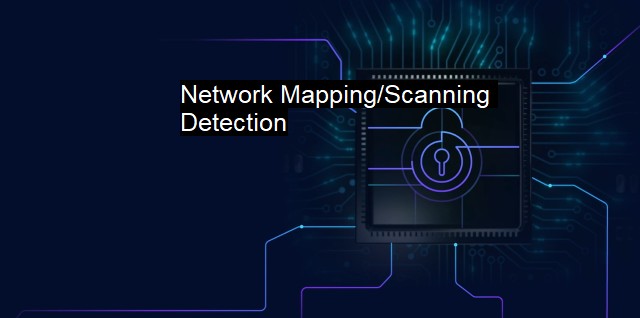What is Network Mapping/Scanning Detection?
Exploring Network Mapping/Scanning Detection as a Critical Component of Cybersecurity: Understanding Techniques and Terminologies
Network Mapping/Scanning Detection is one of the principal components of cybersecurity, primarily used to safeguard and maintain an individual or an organization's online security. That being said, it is important to fully understand what this term encapsulates and how it plays a vital role in cybersecurity.Given the current interlinked global infrastructure, it's important to appreciate the concept of networks. In this digitized world, each device is part of a broader network that interacts with other devices to communicate information. This connection forming a systematic web is the simplistic explanation of a network. The complexity, of course, arises from the size and structure of these networks.
On a more advanced level, network mapping is a process where software visually maps network's devices and their corresponding interconnections. In other words, network mapping allows you to visualize your computing infrastructure in comprehensive models by documenting hardware and software components of an information technology system as well as the systems relationships and dependencies. Primarily, network mapping provides a clear picture of the devices connected and the state of threat or health they possess.
Meanwhile, network scanning can be considered as a diagnostic tool, constantly monitoring your network, striving to protect it from any possible threats. Network scans are mainly conducted to identify live hosts, specific services, and open ports in the system’s infrastructure. They also play a crucial role in inspecting network devices for any misconfigurations or vulnerabilities that might be exploited by black-hat hackers and malicious software.
The concept of 'Detection' follows the completion of mapping and scanning. After a network and its elements have been fully outlined and inspected, you need a correlating cybersecurity function to pinpoint vulnerabilities, irregularities, or threats noticed during scanning. Network scanning detection does precisely that. It detects any irregularities in your network, notifying you about them so that you can take appropriate preventive measures before they are exploited.
Network Detection and Response (NDR), incorporated in advanced antivirus systems, leverages artificial intelligence and machine learning to analyze network behavior. So not only does it identify malicious activities in real-time, but it also takes automatic action against threats before they become a problem.
Effective implementation of network mapping/scanning detection is an integral part of a robust cybersecurity strategy for numerous reasons. Firstly, a detailed map provides a simple way to track and manage devices. Also, security administrators can spot rogue devices or unusual connections swiftly.
Secondly, repeated scanning activities will help organizations understand their network better, making it easier to keep track of how it evolves over time. This is particularly useful when auditing or inspecting your system for adaptability or upgrade requirements.
Thirdly, but perhaps most importantly, scanning can enable faster and more accurate detection of vulnerabilities and threats. A slight but sudden change or an unfamiliar entry in your network could be the indicative alarm of a potential breach or an invasive intervention.
As cyber threats continue to evolve and become more sophisticated, network mapping and scanning detection systems are rapidly advancing to combat these threats. This proactive strategy can identify weaknesses in the system before they are exploited, ensuring a safer and securer digital environment. Staying ahead of potential cyber threats through regular checks, averting them before they manifest into calamitous issues, has become an essential obligation for individuals and corporations alike. Management of any entity, large or small, must make a concerted effort to prioritize attention and resources to cybersecurity considering how much information and equities are at stake. Regular network mapping and scanning detection, therefore, has become a necessity rather than a luxury in the modern digital era.

Network Mapping/Scanning Detection FAQs
What is network mapping/scanning detection?
Network mapping/scanning detection refers to the process of identifying and analyzing network traffic to detect unauthorized scanning and mapping activities. It is an essential component of cybersecurity that helps organizations identify potential threats before they result in network breaches or data loss.How does network mapping/scanning detection help in cybersecurity?
Network mapping/scanning detection helps in cybersecurity by identifying and analyzing potential risks in the network environment. It can help organizations detect unauthorized network activities, identify network vulnerabilities, and prevent potential cyber attacks. It also helps in maintaining network security by actively monitoring network traffic and identifying any suspicious activities.What are the common techniques used for network mapping/scanning detection?
The common techniques used for network mapping/scanning detection include port scanning, vulnerability scanning, network mapping, and protocol analysis. Port scanning involves scanning network ports for vulnerabilities, while vulnerability scanning involves identifying and analyzing network vulnerabilities. Network mapping involves creating a map of the network topology, and protocol analysis involves analyzing network traffic for signs of malicious activities.What are some of the popular tools used for network mapping/scanning detection?
Some of the popular tools used for network mapping/scanning detection include Nmap, Nessus, OpenVAS, Wireshark, and Tcpdump. These tools are designed to scan network traffic, identify network vulnerabilities, and analyze network activity to detect potential threats. They can help organizations ensure network security and prevent cyber attacks.| | A | | | B | | | C | | | D | | | E | | | F | | | G | | | H | | | I | | | J | | | K | | | L | | | M | |
| | N | | | O | | | P | | | Q | | | R | | | S | | | T | | | U | | | V | | | W | | | X | | | Y | | | Z | |
| | 1 | | | 2 | | | 3 | | | 4 | | | 7 | | | 8 | | |||||||